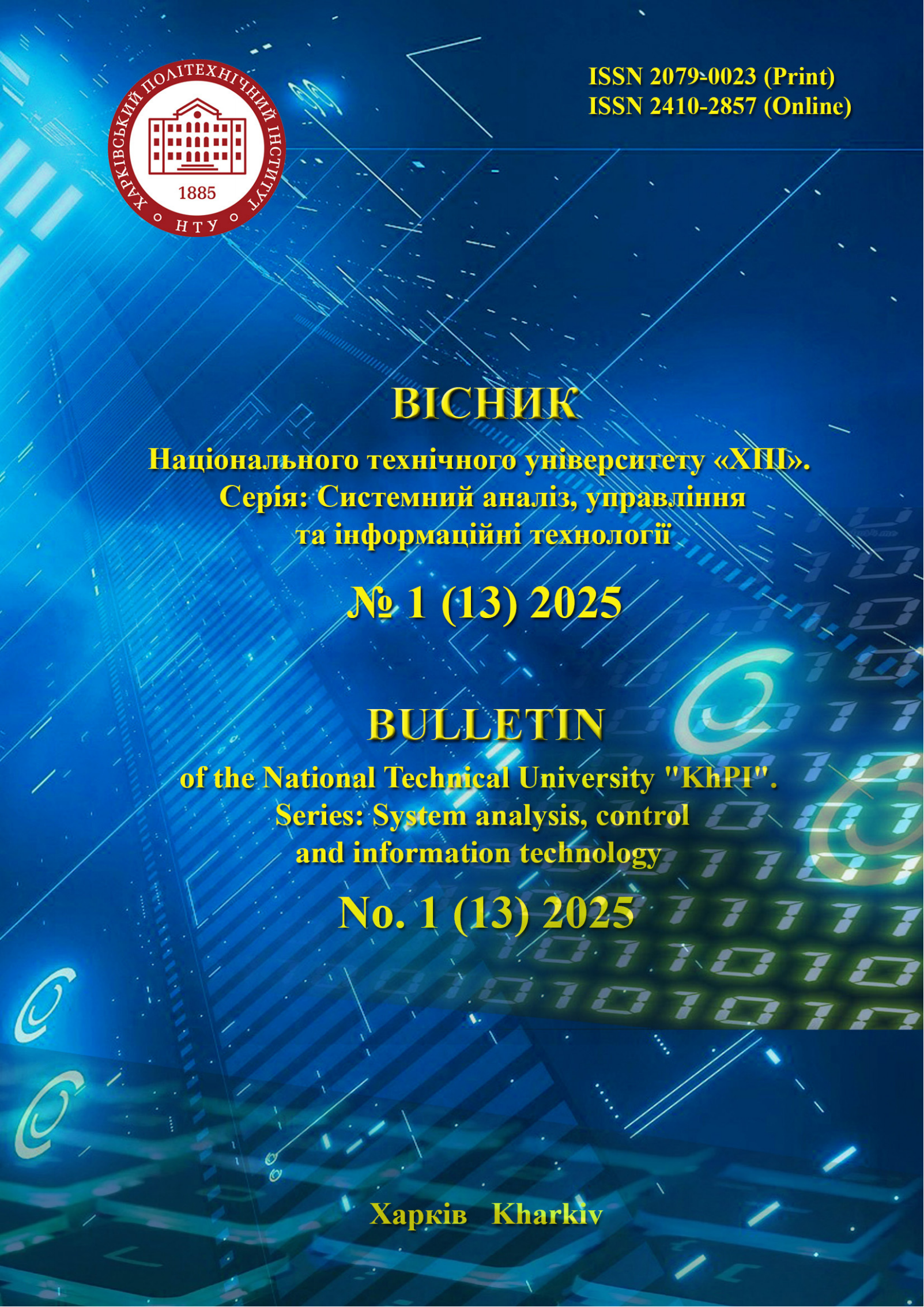ASSESSMENT OF THE QUALITY OF THE STABILIZATION SYSTEM OF SPECIAL EQUIPMENT ON MOBILE VEHICLES
DOI:
https://doi.org/10.20998/2079-0023.2025.01.20Keywords:
tracking, object tracking, stabilization quality, deviation, channel and spatial reliability tracker (CSRT), correlation filterAbstract
The article is devoted to the assessment of the quality of stabilization systems of special equipment used on various types of vehicles, such as combat vehicles, in particular infantry fighting vehicles (IFVs). The main task of such systems is to maintain a stable position or orientation of the object, which avoids external influences and compensates for the movement of the equipment carrier itself. This is especially important for combat assets, where the stability of the equipment affects the accuracy of guidance and the effectiveness of combat operations. Among the features considered are smoothing and mitigating abrupt fluctuations and deviations, as well as stabilizing relative to the target. The article presents a mathematical model and developed software for assessing the quality of stabilization systems of special equipment on mobile vehicles using the method of deviation analysis by calculating deviations in the stabilization process, which takes into account the movement of the carrier. The method involves measuring the angular deviations of the sight relative to the target at each point in time. The main indicators of stabilization quality in the model are mean angular deviation, standard deviation, and maximum deviation. For dynamic target tracking, the principles of a correlation filter are used, which allows you to determine the similarity between the current frame and the reference image of the object. This approach makes it possible to reliably identify an object even in conditions dynamic position change. The correlation tracking described in the article is based on finding an object in the next frame by maximizing the similarity between the current image and the reference. The use of a correlation filter ensures stable subject tracking and adjusts the settings to accurately focus on the target in conditions of changing lighting and angle.
References
Dorczuk M. Modern weapon systems equipped with stabilization systems: division, development objectives, and research problems. Scientific Journal of the Military University of Land Forces. 2020, vol. 197, no. 3, pp. 651–659. DOI: 10.5604/01.3001.0014.3959.
Saluyk O. Mathematical description of systems for space stabilization of equipment assigned for operation on moving vehicles. Electronics and Control Systems. 2023, vol. 3, no. 77, pp. 53–59. DOI:10.18372/1990-5548.77.18004
Lan L., Jiang W., Hua F. Research on the line of sight stabilization control technology of optronic mast under high oceanic condition and big swaying movement of platform. Sensors. 2023, vol. 23, no. 6, 3182. DOI: 10.3390/s23063182
Dobrovodský K., Andris P. Stabilization of mobile weapon aiming. Mechanisms and Machine Science. 2021, vol. 102, pp. 259–265. DOI: 10.1007/978-3-030-75259-0_28
Koh Y. J., Lee C., Kim C. Video stabilization based on feature trajectory augmentation and selection and robust mesh grid warping. IEEE Transactions on Image Processing. 2015, vol. 24, no. 12, pp. 5260-5273. DOI: 10.1109/TIP.2015.2479918
Sushchenko O., Averyanova Y., Ostroumov I., Kuzmenko N., Zaliskyi M., Solomentsev O., Kuznetsov B., Nikitina T., Havrylenko O., Popov A., Volosyuk V., Shmatko O., Ruzhentsev N., Zhyla S., Pavlikov V., Dergachov K., Tserne E. Algorithms for design of robust stabilization systems. Lecture Notes in Computer Science. 2022, vol. 13375, pp. 198–213. DOI: 10.1007/978-3-031-10522-7_15
Sushchenko O., Goncharenko A. Design of robust systems for stabilization of unmanned aerial vehicle equipment. International Journal of Aerospace Engineering. 2016, vol. 2016, 6054081. DOI: 10.1155/2016/6054081
Habashi A., Ashry M., Mabrouk M., Elnashar G. Comparative study among different control techniques for stabilized platform. Engineering Science and Military Technologies. 2018, vol. 2, no. 1, pp. 44–48. DOI: 10.21608/ejmtc.2017.409.1005
Bezvesilna O., Petrenko О., Halytskyi V., Ilchenko M. Devising and introducing a procedure for measuring a dynamic stabilization error in weapon stabilizers. Eastern-European Journal of Enterprise Technologies. 2020, vol. 1, no. 9(103), pp. 39–45. DOI: 10.15587/1729-4061.2020.196086
Tchigirinsky J., Chigirinskaya N., Evtyunin A. Stability assessment methods of technological processes. MATEC Web of Conferences. 2021, vol. 346, 03013. DOI: 10.1051/matecconf/202134603013
Song Z. Multi-Sensor Fusion and Deep Learning: A New Frontier in Stabilization Algorithm Optimization. Applied and Computational Engineering. 2024, vol. 80, pp. 136–142. DOI: 10.54254/2755-2721/80/2024CH0080
Lukežič A., Vojír T., Zajc L., Matas J., Kristan M. Discriminative correlation filter tracker with channel and spatial reliability. International Journal of Computer Vision. 2018, vol. 126, pp. 671–688. DOI: 10.1007/s11263-017-1061-3
Liu Y., Yan H., Zhang W., Li M., Liu L. An adaptive spatiotemporal correlation filtering visual tracking method. PLoS ONE. 2023, vol. 18, no. 1, e0279240. DOI: 10.1371/journal.pone.0279240
Bishop C. M. Pattern recognition and machine learning. Springer New York, NY, 2006. 798 p.
Hall P., Peng L., Yao Q. Moving-maximum models for extrema of time series. Journal of Statistical Planning and Inference. 2002, vol. 103, no. 1–2, pp. 51–63. DOI: 10.1016/S0378-3758(01)00197-5
Wang Y. Smoothing Splines: Methods and Applications. Chapman and Hall/CRC, 2011. 384 p. DOI: 10.1201/b10954
Howse J., Minichino J. Learning OpenCV 4 computer vision with Python. Packt Publishing, 2020. 372 p.
Johansson R. Numerical Python: scientific computing and data science applications with Numpy, SciPy and Matplotlib. Apress Berkeley, CA, 2018. 723 p. DOI: 10.1007/978-1-4842-4246-9
Downloads
Published
How to Cite
Issue
Section
License

This work is licensed under a Creative Commons Attribution 4.0 International License.
Authors who publish with this journal agree to the following terms:
- Authors retain copyright and grant the journal right of first publication with the work simultaneously licensed under a Creative Commons Attribution License that allows others to share the work with an acknowledgement of the work's authorship and initial publication in this journal.
- Authors are able to enter into separate, additional contractual arrangements for the non-exclusive distribution of the journal's published version of the work (e.g., post it to an institutional repository or publish it in a book), with an acknowledgement of its initial publication in this journal.
- Authors are permitted and encouraged to post their work online (e.g., in institutional repositories or on their website) prior to and during the submission process, as it can lead to productive exchanges, as well as earlier and greater citation of published work (See The Effect of Open Access).


